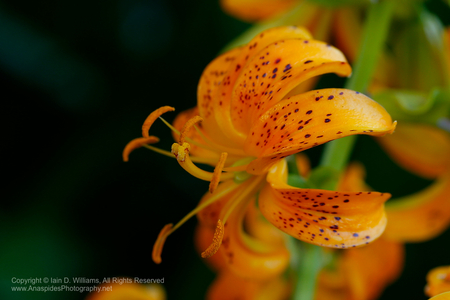Spring and Summer is Flower Season in Tasmania
 Thursday, January 19, 2017 at 10:32PM
Thursday, January 19, 2017 at 10:32PM  Spring and summer in Tasmania is flower season and the diversity of flowers, indigenous or introduced, is staggering.
Spring and summer in Tasmania is flower season and the diversity of flowers, indigenous or introduced, is staggering.
LEFT: Tiger Lily (Lilium) showing pollen abundant stamens and sticky pistil (click to enlarge).
The Tiger Lily (Lilium) grows from a bulb and has large prominent flowers. It is endemic to the temperate zone in the northern hemisphere, where it can be found woodland, grassland and montane habitats. The flowers are large, often fragrant, and come in a range of colours including whites, yellows, oranges, pinks, reds and purples. Markings include spots and brush strokes.
Pollination
Lilys are pollinated primarily by butterflies and bees, which are attracted to the bright colours of the flower pedals (modified leaves that have evolved specially to aid in the pollination of the plant). The insects move between flowers anciently rubbing themselves on the large and well developed stamens; pollen easily attaches to the body of the insect and is then transported from one plant to the next where it becomes attached to the sticky pistil. From the pistil, the pollen works its way down the style and into the ovary. There, seeds are formed within a small pod.
Odour
Plants tend to have their scent output at maximal levels only when the flowers are ready for pollination and when its potential pollinators are active. Plants that maximize their output during the day are primarily pollinated by bees or butterflies, whereas those that release their fragrance mostly at night are pollinated by moths and bats.
Glossary
Ovary - Female reproductive organ of the flower.
Pedals - Petals are modified leaves that surround the reproductive parts of flowers.
Stamens - The portion of the flower that carries the pollen.
Style - The part of a flower stalk where the parts of the flower are attached.
Pistil - The female reproductive part of the flower, usually centrally positioned leading to the style, ovary and other internal parts of the flower.


